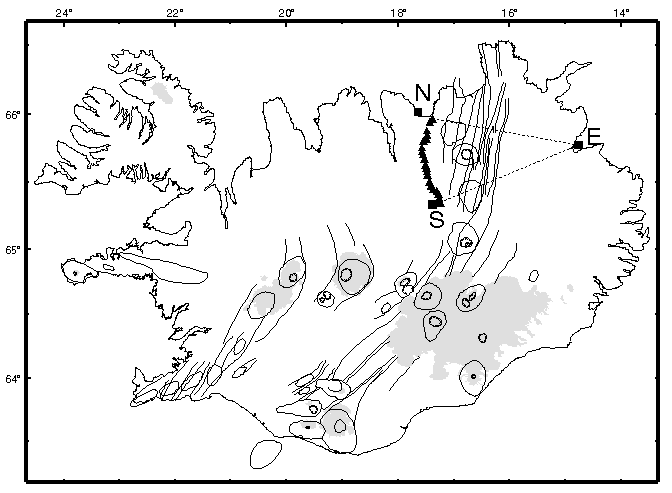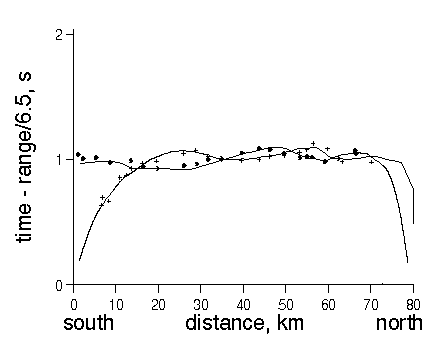
Part 1: Shallow Crustal Structure

Fig 1: Map of iceland showing tectonic features, stations (triangles) of the B array and shots (squares). This section discusses data from shots labled S and N. (PostScript version of map).

Fig 2: Traveltimes (reduced to 6.5 km/s) along the B array from the north (triangles) and south (crosses) shots as a function of distance from the south shot. Solid curves are predicted traveltimes for velocity model in figure 3. (PostScript version of plot).

Fig 3: Compressional velocity model along the B96 array based on traveltime data from the north and south shots. Note the anticorrelated anomalies, indative of velocity heterogeneities in the mid-crust. (Color PostScript and B&W PostScript versions of plot).
Summary
Design. Two 100 kg shots, one south of the B96 array at Isholsvatn (lake) and the other north of the array at Skjalfandi (bay) are used to determine the shallow compressional velocity structure of the crust (to a depth of 8 km).
Analysis of this shot began by picking traveltimes for each of the 23 stations of the B96 array. The 100 kg shots yielded low noise seismograms whose first arrivals were easiy picked "by eye". Both traveltime curves showed an oscillatory pattern with variations of about 0.2 seconds and wavelengths of 20-30 km. The pattern for the two shots is anti-correlated (a "parallax" effect), indicating that it is not due to near-surface structure, but rather originates from velocity heterogeneities that are several kilometers deep. The RTMOD raytracing program was used to construct a 2D velocity structure that matched the observed traveltimes.
ResultsThe crustal model has two distinct features: Surface velocities are a uniform 3.7 km/s along the profile except along the northern 20 km where low velocity (2.4 km/s) sediments are known to occur. At depths greater than about 1 km, isovelocity contours oscillate with a wavelength of 30-40 km. This oscillation has no clear expression in the surface geology. As this profile is along strike of the the streading direction, we speculate that it may be associated with fossil "roots" of central volcanos. Mid crustal velocity highs have been identified under some of Iceland's central volcanos. The 30 km spacing between the velocity highs is similar to the spacing between currently-active central volcanoes.
Supporting data
| name | location | size | lat | lon | depth |
| north shot | Skjalfandi (bay) | 100 kg | 66.023727 | -17.646980 | 0.03 |
| south shot | Isholsvatn (lake) | 100 kg | 65.322502 | -17.386499 | -0.36 |